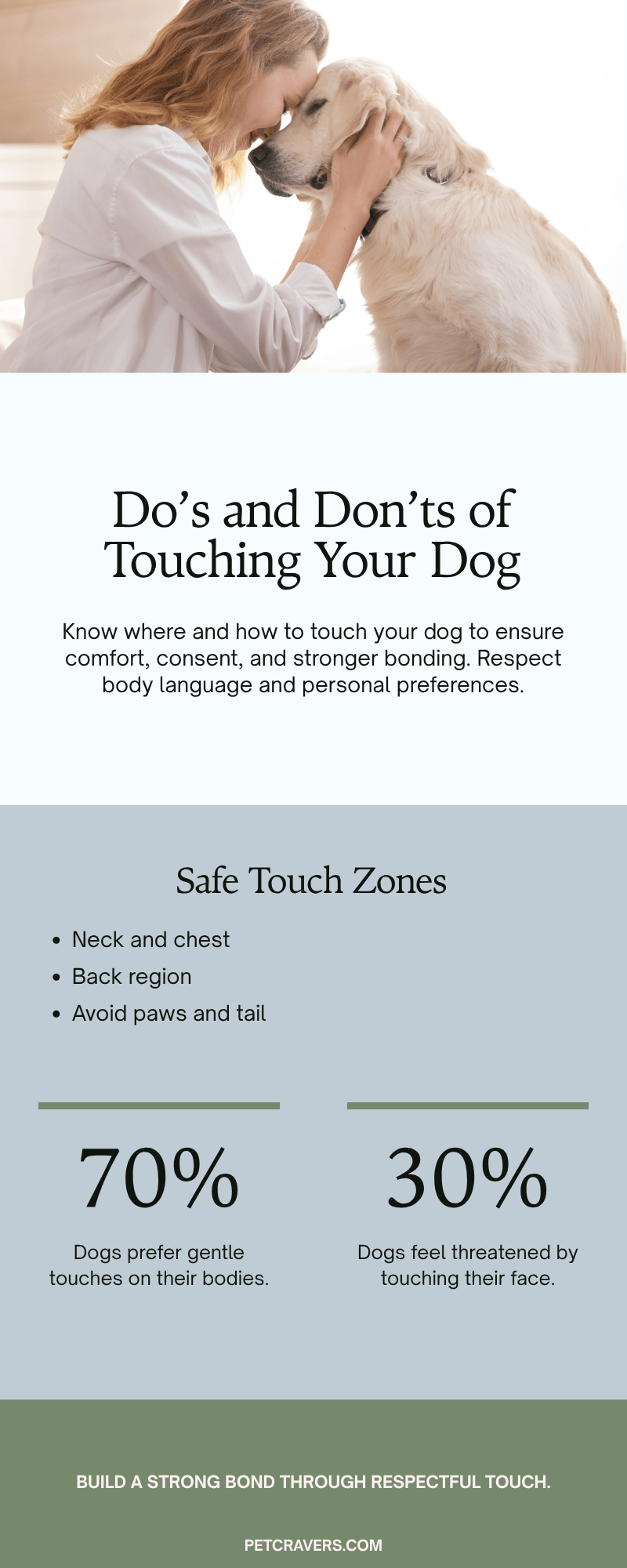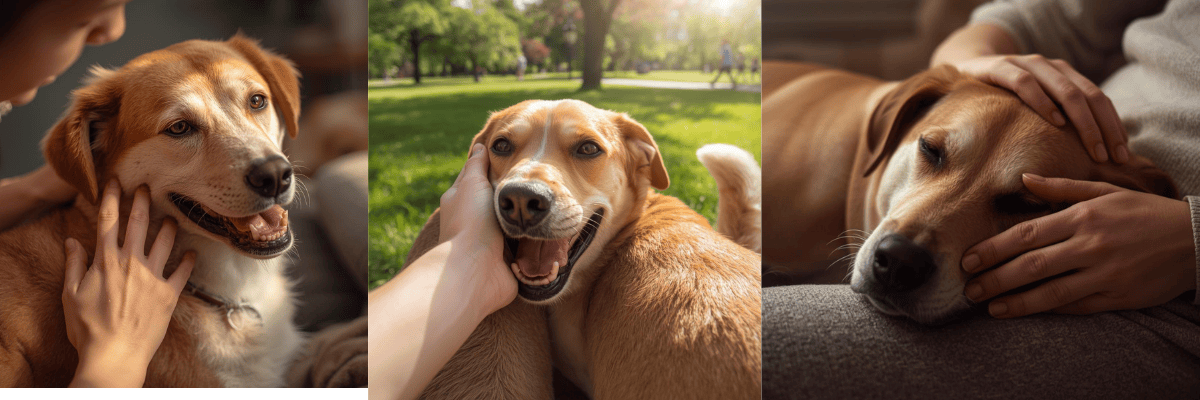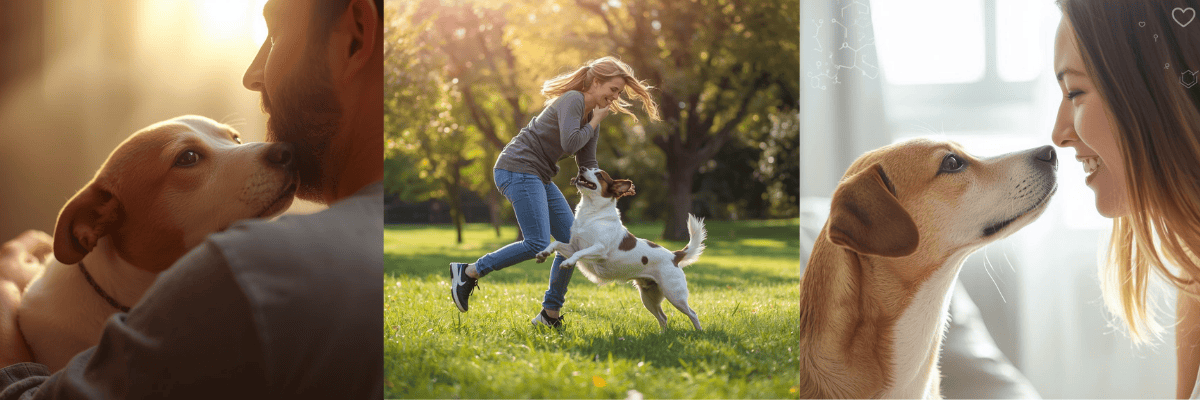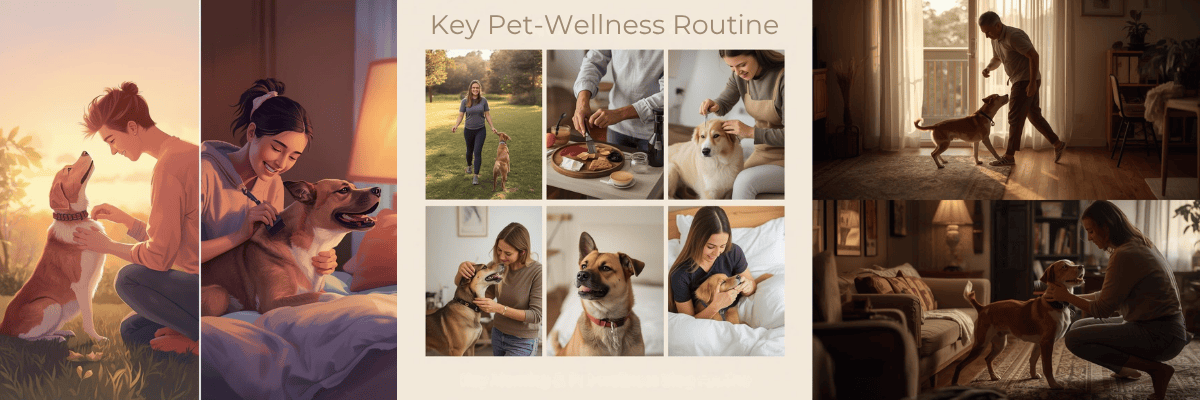Introduction
Dogs are incredibly expressive creatures, communicating not just through barks and body language, but also through physical touch. From a gentle nudge to a warm lean against your leg, touch plays a central role in how dogs show affection and build connections with their human companions. Understanding the nuances of canine touch can deepen your bond, improve communication, and help you respond appropriately to your dog’s emotional needs.
Just as humans often use hugs, handshakes, or pats to convey care and reassurance, dogs rely on a variety of tactile signals to express love, trust, and comfort. Observing and responding to these gestures can help strengthen your relationship and ensure that your dog feels safe and valued.
In this post, we’ll explore the many ways dogs use touch to communicate affection, how they respond to human touch, and practical tips for engaging with your dog in ways that foster trust, relaxation, and emotional connection. Whether you’re a new dog owner or have years of experience, understanding the role of touch can transform everyday interactions into meaningful bonding moments.
Understanding Canine Body Language
Before fully appreciating the role of touch in canine affection, it’s important to understand how dogs communicate through their bodies. Dogs rely heavily on nonverbal signals, and physical gestures often convey more than barks or vocalizations. By learning to interpret these cues, you can respond appropriately and strengthen your bond.

1. Affiliative vs. Defensive Signals
Dogs use touch differently depending on their emotional state. Affiliative touch—such as nudging, leaning, or gentle pawing—signals friendliness, trust, and a desire for closeness. In contrast, defensive or stressed behavior—like stiffening, growling, or avoiding contact—indicates discomfort. Recognizing these differences helps ensure that interactions remain positive and consensual.
2. Signs Your Dog Enjoys Physical Contact
- Relaxed posture and wagging tail
- Soft eyes and relaxed ears
- Leaning against you or pressing their body gently
- Licking or gentle nudging
When you notice these signals, it’s a clear sign that your dog welcomes touch and enjoys your presence, creating the perfect opportunity for bonding.
3. Observing Subtle Signals
Dogs also communicate subtly—slight shifts in weight, tail position, or paw movements can indicate their comfort level. By paying attention to these cues, you can learn what types of touch your dog prefers, ensuring that every interaction strengthens trust rather than causing stress.
Understanding canine body language is the foundation for meaningful touch. When you recognize and respect your dog’s signals, you can use touch as a powerful tool for affection, reassurance, and bonding.
Types of Touch Dogs Use to Show Affection
Dogs communicate love and trust in a variety of tactile ways. By recognizing these forms of touch, you can better understand your dog’s emotions and respond in ways that strengthen your bond.
1. Nudging and Leaning
A gentle nudge with the nose or a lean against your leg is a common way dogs seek attention and closeness. This behavior is a subtle but powerful signal of trust—they are letting you know they feel safe and comfortable around you.
2. Licking
Licking is more than just a grooming behavior. Dogs often lick their humans as a sign of affection, care, and social bonding. While it can sometimes be attention-seeking, it’s generally a positive gesture indicating that your dog feels connected to you.
3. Resting on or Against You
When a dog chooses to rest its head or body against you, it is demonstrating comfort and security. This type of touch is a clear expression of trust and closeness, often seen in dogs who have strong emotional bonds with their owners.
4. Pawing or Gentle Nudges
Dogs may paw at you lightly or nudge your hand when they want interaction or approval. This behavior is their way of initiating contact and engagement, signaling that they value your attention and companionship.
5. Cuddling or Snuggling
Some dogs enjoy curling up next to you or snuggling close, especially during quiet times. This behavior conveys both affection and a desire for reassurance, allowing your dog to feel safe while reinforcing your bond.
By observing and understanding these tactile gestures, you can respond in ways that make your dog feel valued, safe, and loved, creating a stronger, more affectionate relationship.
How Dogs Respond to Human Touch
Just as dogs use touch to communicate affection, they also respond positively to touch from their human companions. Gentle physical contact can reduce stress, promote relaxation, and strengthen the emotional connection between you and your dog.

1. Petting and Cuddling
Most dogs enjoy gentle petting on the neck, chest, or back, and this type of physical contact can have a calming effect. Regular petting sessions help your dog feel secure and loved, reinforcing your role as a trusted companion.
2. Oxytocin Release
Studies have shown that positive physical interaction triggers the release of oxytocin—the “love hormone”—in both dogs and humans. This hormone promotes feelings of bonding, trust, and relaxation, making touch a scientifically proven method of enhancing emotional connection.
3. Touch as Reassurance
During stressful situations—like thunderstorms, vet visits, or new environments—a gentle touch can reassure your dog that they are safe. Even simple gestures, like placing a hand on their shoulder or letting them lean against you, can reduce anxiety and foster a sense of comfort.
4. Encouraging Positive Behavior
Touch paired with verbal praise or treats can reinforce desired behaviors, such as sitting calmly, following commands, or remaining relaxed in new settings. This combination of tactile and verbal feedback strengthens both obedience and the emotional bond.
By understanding how dogs respond to human touch, you can use physical contact not just for affection, but as a tool to communicate love, provide reassurance, and reinforce positive behavior.
Appropriate Touch: Do’s and Don’ts
While dogs enjoy touch, it’s important to understand where, how, and when to touch them to ensure positive interactions. Respecting your dog’s boundaries enhances trust and prevents stress or defensive behavior.

1. Areas Dogs Generally Like to Be Touched
- Neck, chest, and shoulders: These are often safe, comforting areas for petting.
- Back and sides: Gentle strokes along the back or sides can be soothing.
- Base of the tail (for some dogs): Some dogs enjoy gentle scratching here, but always observe their reaction.
2. Areas to Avoid or Approach with Caution
- Paws and tail: Many dogs are sensitive and may feel uncomfortable or threatened.
- Ears and face: Some dogs tolerate gentle touches, but others may dislike it, especially unfamiliar dogs.
- Muzzle or head (for some dogs): Approach slowly and watch for signs of discomfort.
3. Reading Your Dog’s Signals
Pay attention to body language cues. Signs your dog is uncomfortable include stiffening, turning away, growling, or tucking the tail. Conversely, relaxed posture, wagging tail, soft eyes, and leaning into your touch indicate enjoyment.
4. Respecting Consent and Comfort
Always allow your dog to initiate contact or indicate readiness. Forcing touch can lead to stress, anxiety, or even defensive behavior. Positive interactions are always based on mutual comfort and consent.
By following these do’s and don’ts, you can make every interaction safe, enjoyable, and bonding-focused, helping your dog feel valued and respected.
Touch in Different Contexts
The role of touch in canine affection can vary depending on the situation. Understanding how to use touch appropriately in different contexts helps strengthen your bond while supporting your dog’s emotional needs.
1. Playtime
During play, touch can be used as encouragement and positive reinforcement. Light nudges, gentle holding, or petting after a successful trick or fetch session communicates approval and excitement, making playtime more enjoyable and reinforcing trust.
2. Training
Touch is a valuable tool in training when paired with verbal praise or treats. A gentle pat or scratch on the chest can reward desired behavior, signaling to your dog that they are doing well. This combination strengthens both obedience and your emotional connection.
3. Comforting During Anxiety or Illness
Dogs often seek physical reassurance when stressed, anxious, or unwell. Gentle stroking, leaning, or resting with your dog can provide comfort and help regulate their emotional state. This supportive touch lets your dog know they are safe and cared for.
4. Age and Life Stage Considerations
- Puppies: Touch helps socialize them, teach trust, and form early bonds.
- Adult dogs: Touch reinforces existing bonds and provides emotional support.
- Senior dogs: Gentle contact can reduce anxiety, alleviate discomfort, and maintain a sense of security.
By adapting the type and intensity of touch to the situation and life stage, you can ensure that physical contact always strengthens trust, reduces stress, and fosters affection.
Benefits of Touch in Strengthening Bonding
Touch is a fundamental way dogs and humans communicate affection. Using touch mindfully offers a variety of emotional and behavioral benefits that deepen your bond.
1. Enhances Emotional Connection and Trust
Physical contact fosters a sense of safety and reassurance. When your dog leans on you, rests against you, or enjoys gentle petting, it signals trust. Over time, these interactions build a strong emotional connection that reinforces mutual affection.
2. Reduces Anxiety and Promotes Relaxation
Gentle touch has a calming effect on dogs, lowering stress hormones and encouraging relaxation. Whether during thunderstorms, vet visits, or after an energetic play session, touch helps dogs feel secure and reduces signs of anxiety or restlessness.
3. Encourages Cooperative and Positive Behavior
When touch is paired with rewards or verbal praise, it reinforces positive behaviors. Dogs learn to associate physical affection with good experiences, making them more cooperative and attentive.
4. Benefits Human Companions as Well
Touching your dog isn’t just beneficial for them—it also triggers oxytocin release in humans, reducing stress and promoting feelings of love and well-being. This shared experience strengthens the bond for both parties.
5. Promotes Social Cohesion
In multi-dog households or among human family members, touch helps establish friendly and cooperative interactions, encouraging social harmony and reducing tension.
By recognizing and using touch appropriately, you create a cycle of trust, affection, and emotional enrichment that benefits both you and your dog, strengthening your bond in meaningful ways.
Limitations and Considerations
While touch is a powerful tool for building canine affection, it’s important to understand its limitations and use it thoughtfully to avoid stress or discomfort.
1. Not All Dogs Enjoy Prolonged Contact
Some dogs prefer minimal touch or short interactions. Over-petting or forced cuddling can create stress or avoidance behavior. Always observe your dog’s signals and respect their preferences.
2. Importance of Consent and Body Language
Dogs communicate consent through body language. Signs of discomfort include stiffening, yawning, turning away, growling, or tucking the tail. Respecting these cues is essential for maintaining trust.
3. Individual and Breed Differences
Breed, age, and personality influence tactile preferences. For example, some terriers may enjoy constant interaction, while more independent breeds may prefer occasional touch. Tailor your approach based on your dog’s individual tendencies.
4. Avoid Using Touch as Punishment
Touch should never be associated with punishment or negative reinforcement. Using physical contact in anger or frustration can damage trust and create fear, undermining the bond.
5. Context Matters
Touch during stressful or overstimulating situations may not always be calming. Learn to choose the right moments for affection, such as quiet times, after play, or during relaxation routines.
By being mindful of these considerations, you can ensure that touch remains a positive, enjoyable, and safe way to strengthen your relationship with your dog.
Conclusion
Touch is one of the most powerful ways dogs communicate affection and build trust with their human companions. From gentle nudges and leaning to licking and snuggling, these tactile signals convey love, comfort, and security. Similarly, dogs respond positively to human touch, which can reduce stress, promote relaxation, and strengthen emotional bonds.
By understanding your dog’s body language, respecting boundaries, and using touch appropriately across different contexts—playtime, training, or moments of comfort—you can deepen your connection and foster a relationship built on trust and affection.
Remember, not all dogs respond the same way, and consent is key. Observing your dog’s reactions ensures that every interaction is enjoyable and meaningful. When used mindfully, touch becomes more than a simple gesture—it becomes a universal language of love, enriching both your dog’s emotional well-being and your own.
Incorporating touch into your daily interactions can transform ordinary moments into opportunities for connection, creating a stronger, happier, and more affectionate bond with your canine companion.




Leave a Reply